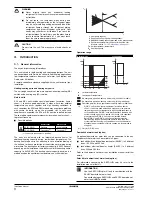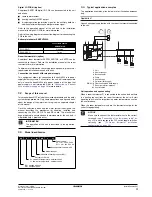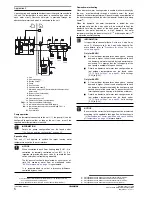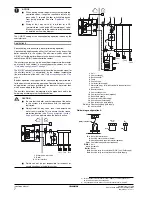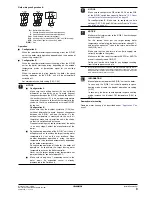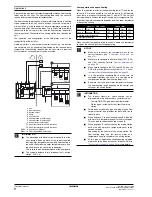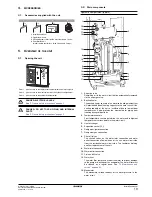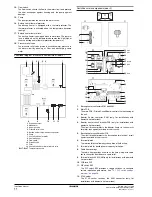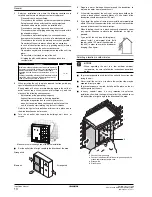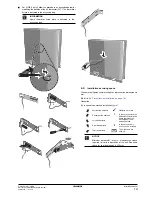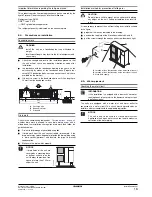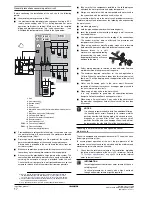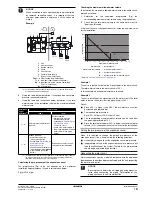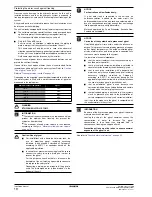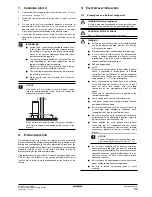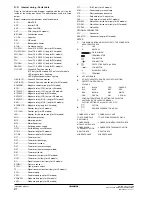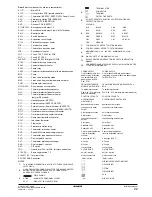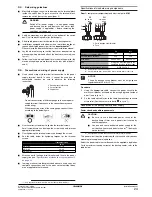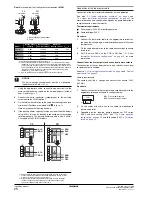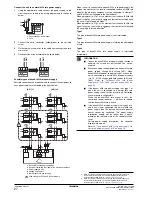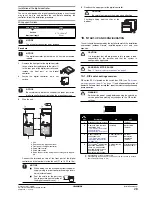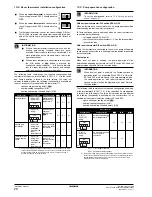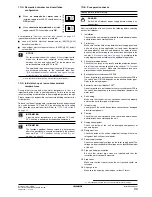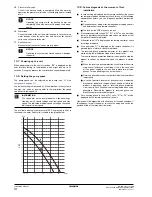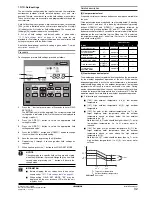
Installation manual
17
E(D/B)(H/L)Q011~016BB
Unit for air to water heat pump system
4PW67904-1 – 01.2011
General precautions concerning water circuit
Before continuing the installation of the unit, check the following
points:
■
the maximum water pressure is 4 bar,
■
the maximum water temperature during space heating is 65°C
(safety device setting) and 75°C
(1)
during domestic hot water
operation (safety device setting). Make sure that the installed
piping and piping accessories (e.g., valve, connections, ...) can
withstand the temperatures as shown in the figure below.
1 Unit
2 Heat exchanger
3 Backup heater
(2)
4 Pump
5 Shut-off valve
6 Motorised 3-way valve (delivered with domestic hot water
tank)
7 Motorised 2-way valve (field supply)
8 Collector (field supply)
9 Domestic hot water tank (optional)
10 Booster heater
(3)
11 Heat exchanger coil
FCU1...3 Fan coil unit (optional)
FHL1...3 Floor heating loop
T Room thermostat (optional)
■
Provide adequate safeguards in the water circuit to be sure that
the water pressure will never exceed the maximum allowable
working pressure (4 bar).
■
Drain taps must be provided at all low points of the system to
permit complete drainage of the circuit during maintenance.
A drain valve is provided in the unit to drain the water from the
unit water system.
■
Make sure to provide a proper drain for the pressure relief valve
to avoid any water coming into contact with electrical parts.
■
Air vents must be provided at all high points of the system. The
vents should be located at points which are easily accessible for
servicing. An automatic air purge is provided inside the unit.
Check that this air purge valve is not tightened too much so that
automatic release of air in the water circuit remains possible.
■
Take care that the components installed in the field piping can
withstand the water pressure and water temperature.
■
Always use materials which are compatible with water used in
the system and with the materials used in the unit.
If air, moisture or dust gets in the water circuit, problems may occur.
Therefore, always take into account the following when connecting
the water circuit:
■
use clean pipes only,
■
hold the pipe end downwards when removing burrs,
■
cover the pipe end when inserting it through a wall so that no
dust and dirt enter.
■
Use a good thread sealant for the sealing of the connections.
The sealant must be able to withstand the pressures and
temperatures of the system.
■
When using non-brass metallic piping, make sure to insulate
both materials from each other to prevent galvanic corrosion.
■
Because brass is a soft
material, use appropriate tooling
for connecting the water circuit.
Inappropriate tooling will cause
damage to the pipes.
■
Select piping diameter in relation to required water flow and
available external static pressure of the pump.
■
The minimum required water flow for the unit operation is
16 l/min. When the water flow is lower than this minimum value,
flow error
7H
will be displayed and the operation of the unit will
be stopped.
■
Never use Zn-coated parts in the water circuit. Excessive
corrosion of these parts may occur as copper piping is used in
the unit's internal water circuit.
■
When using a 3-way valve in the water circuit.
It is very important to guarantee full separation between
domestic hot water and floor heating water circuit.
■
When using a 3-way valve or a 2-way valve in the water circuit,
the maximum change over time of the valve shall be less than
60 seconds.
Checking the water volume and expansion vessel
pre-pressure
The unit is equipped with an expansion vessel of 10 litre which has a
default pre-pressure of 1 bar.
To assure proper operation of the unit, the pre-pressure of the
expansion vessel might need to be adjusted and the minimum and
maximum water volume must be checked.
1
Check that the total water volume in the installation, excluding
the internal water volume of the unit, is 20 l minimum. Refer to
"14. Technical specifications" on page 54
to know the internal
water volume of the unit.
(1) Be sure that the correct field settings are active or selected according to
the applicable tank type. See field settings in
"[4] Backup/booster heater
operation and space heating off temperature" on page 34
for more details.
(2) For tank without electrical booster heater (EKHTS), the backup heater will
be used in domestic water heating mode.
(3) Only applicable for tank with built-in electrical booster heater (EKHW*).
M
FCU1
FCU2
FCU3
8
M
FHL1
FHL2
FHL3
9
10 11
6
7
T
75
°
C
(EKHTS)
75
°
C
(EKHTS)
65
°
C
(EKHW*)
65
°
C
(EKHW*)
65
°
C
65
°
C
5
4
2
3
1
NOTICE
It is strongly recommended to install an additional filter on
the heating water circuit. Especially to remove metallic
particles from the field heating piping, it is advised to use a
magnetic or cyclone filter which can remove small
particles. Small particles can damage the unit and will not
be removed by the standard filter of the heat pump unit.
INFORMATION
In most applications this minimum water volume will have a
satisfying result.
In critical processes or in rooms with a high heat load
though, extra water volume might be required.

